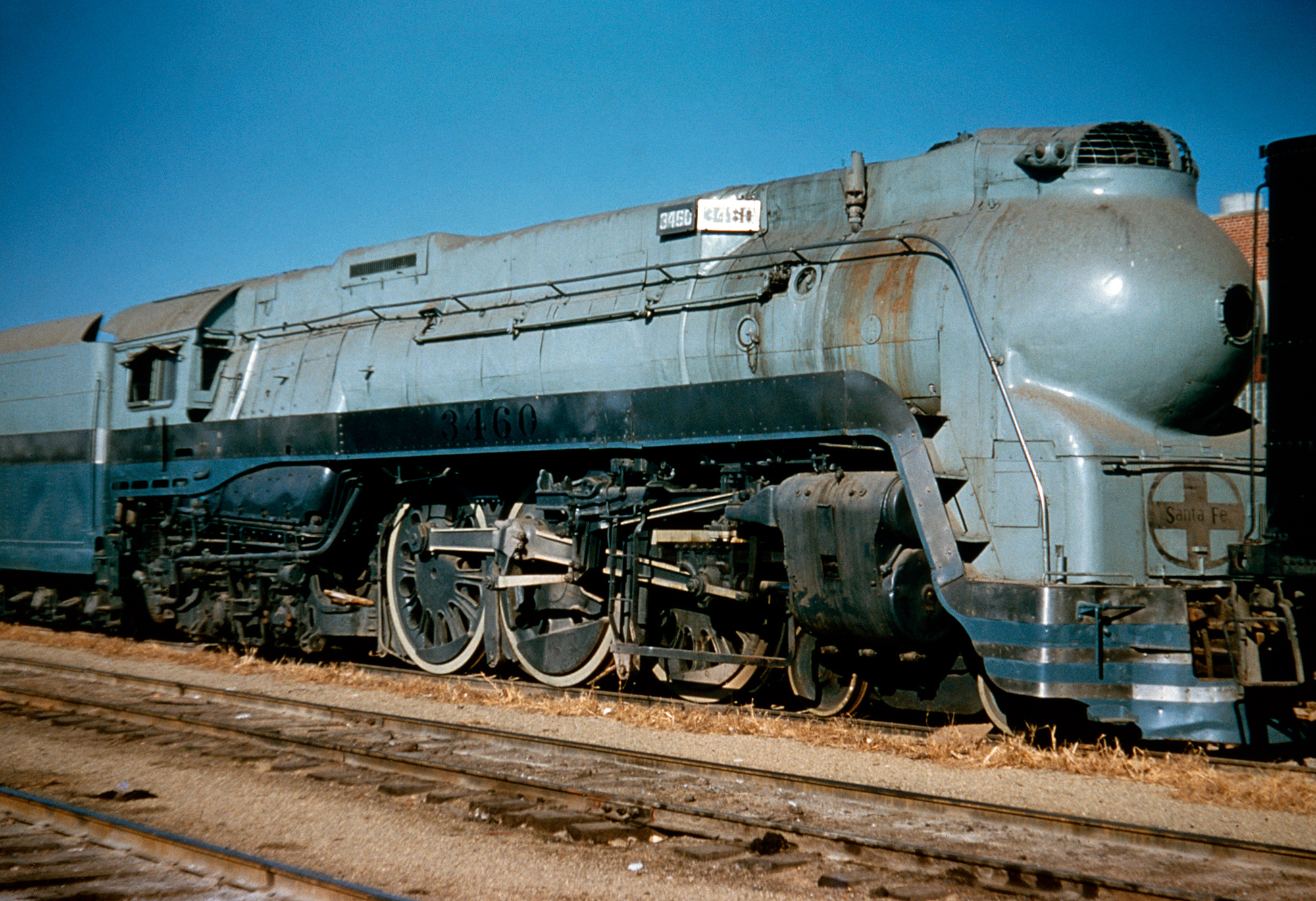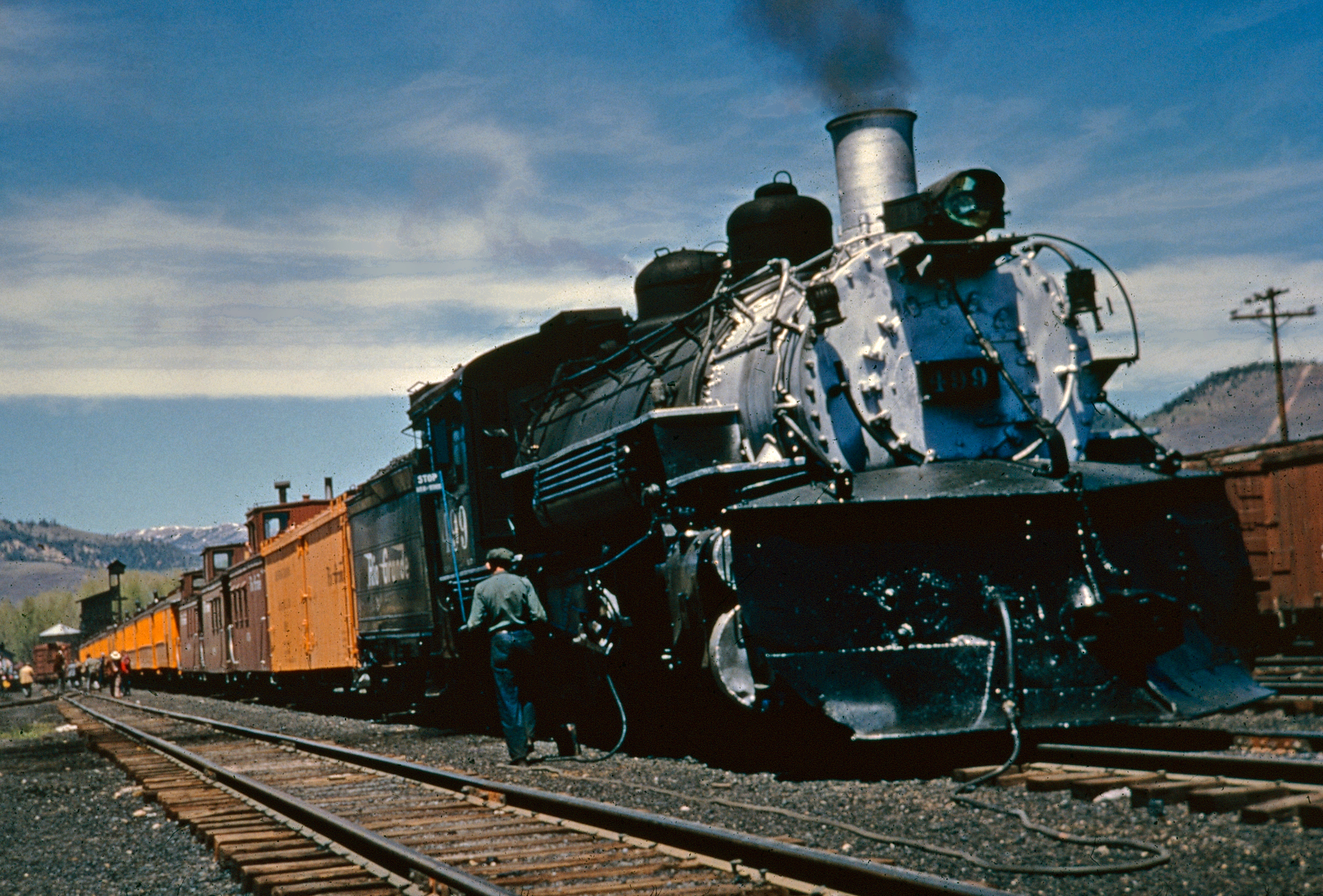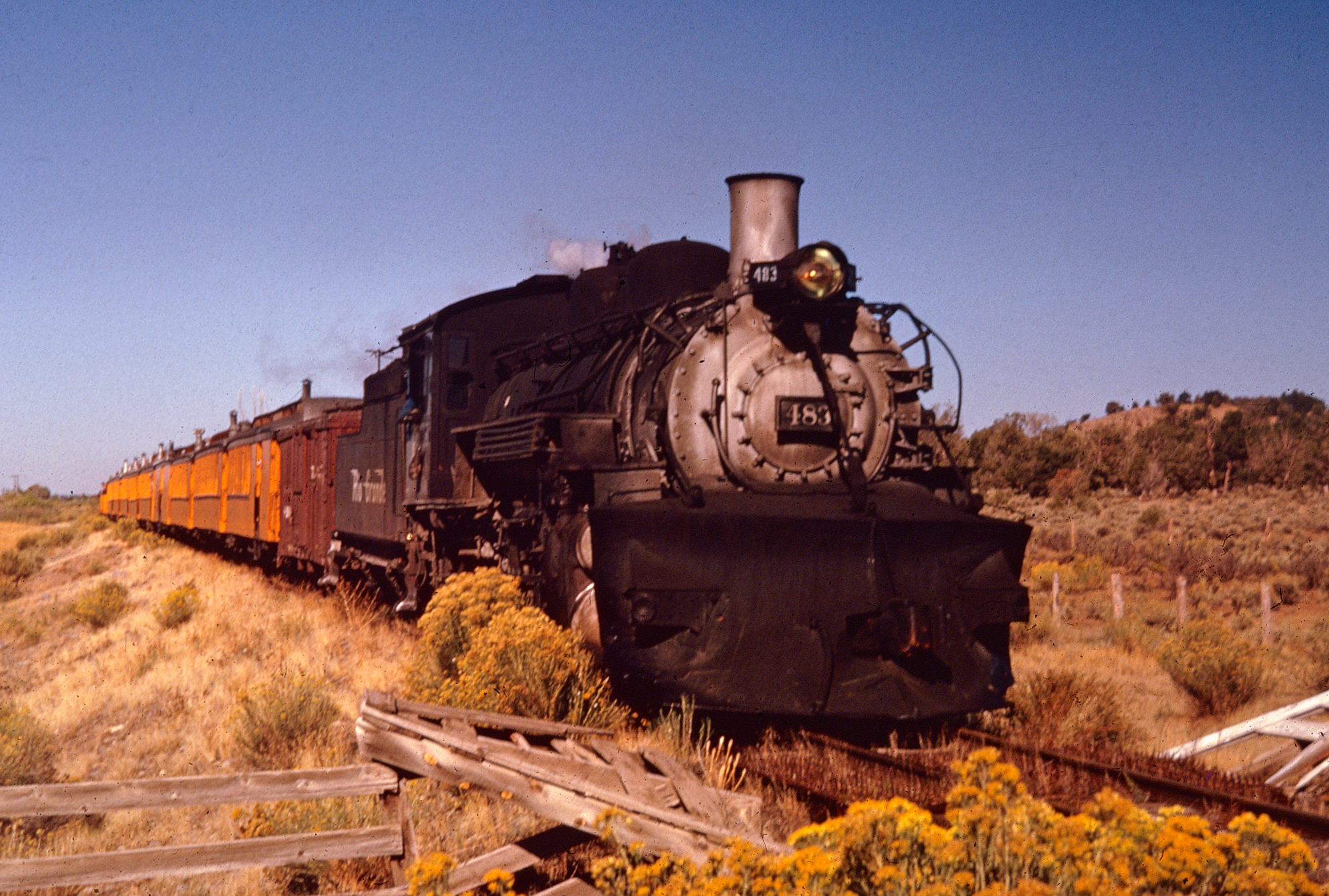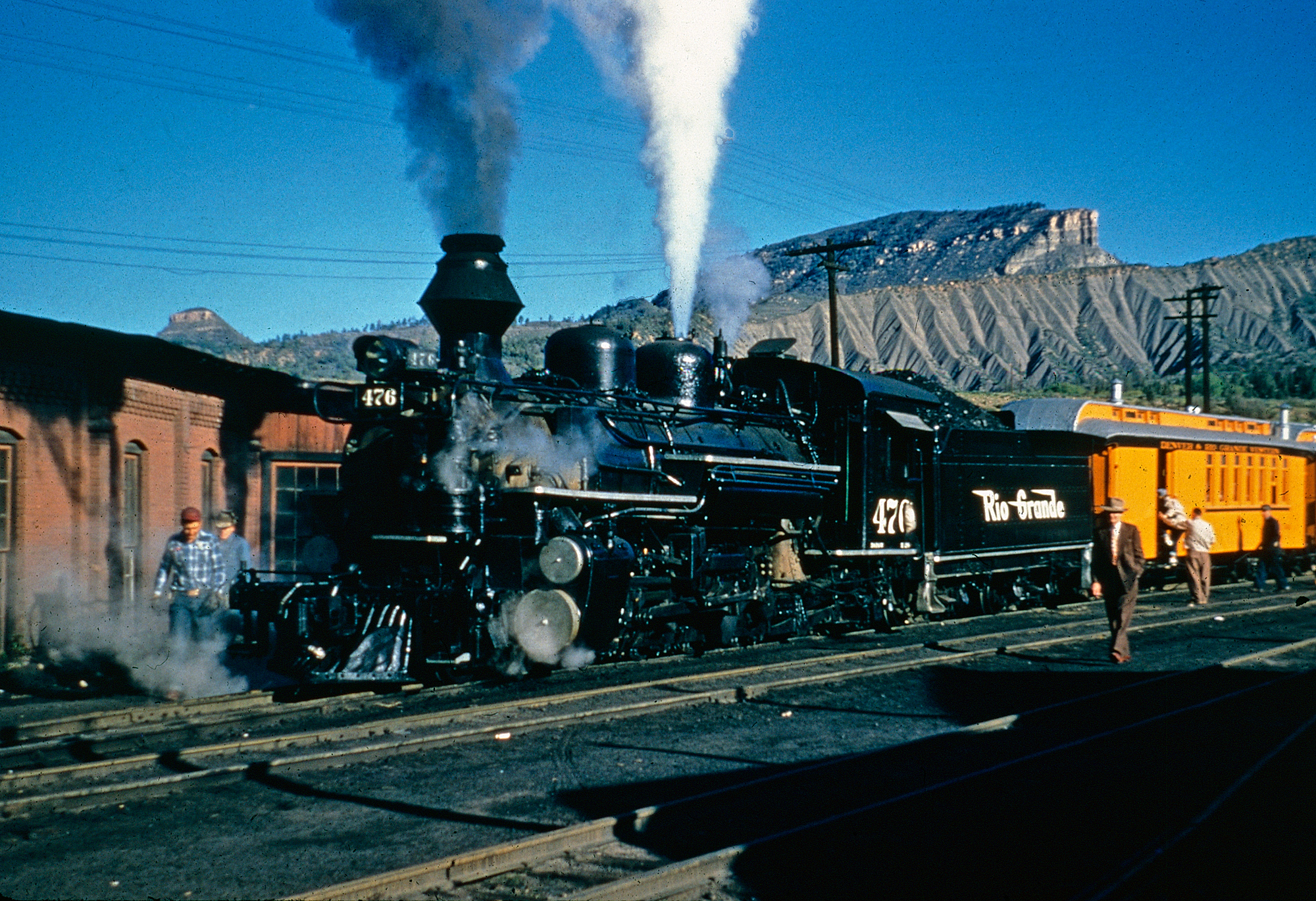Santa Fe 4-6-4 "Blue Goose" (#3460): Specs, History, Photos
Last revised: February 25, 2025
By: Adam Burns
In 1927, the Santa Fe expanded its steam fleet by acquiring ten 4-6-4s, numbered 3450-3459, from the Baldwin Locomotive Works.
Interestingly, these engines were not dubbed "Hudsons" like their counterparts on other lines. Instead, Santa Fe classified them as an extension of their 3400 class Pacifics. Built originally as coal burners equipped with Duplex Stokers, these locomotives were converted to oil burners in 1932.
During the 1930s these machines receive significant upgrades, including the installation of 79-inch drivers and an increase in boiler pressure to 230 psi, which boosted their tractive effort to 43,300 pounds.
The improvements did not stop there. In 1936, Santa Fe ordered six more from Baldwin numbered 3460-3465.
These new locomotives, built as oil burners, represented a leap in technological prowess. Notably, number 3460, known as the "Blue Goose," stands out as the only streamlined locomotive in the Santa Fe fleet.
This last batch of six featured impressive specifications: 23.5 x 29.5-inch cylinders, 84-inch drivers, a boiler pressure of 300 psi, and a tractive effort of 49,300 pounds.
The "Blue Goose" was used extensively in Santa Fe promotional materials during that time. Sadly, it was later sold for scrap during the 1950s.
 Santa Fe 4-6-4 #3460, nicknamed the "Blue Goose," sits in the dead line shortly before she was scrapped in 1956. It was the only streamlined steam locomotive the AT&SF owned. American-Rails.com collection.
Santa Fe 4-6-4 #3460, nicknamed the "Blue Goose," sits in the dead line shortly before she was scrapped in 1956. It was the only streamlined steam locomotive the AT&SF owned. American-Rails.com collection.Development
Santa Fe's 3460 class consisted of six 4-6-4 "Super Hudson" types, buil by the Baldwin Locomotive Works in 1937 for service on the railroad's main line between La Junta, Colorado and Chicago.
This particular division, characterized by its relatively flat terrain, was ideally suited for the 4-6-4s. These locomotives were markedly larger than the earlier 3450 class with a flexibility that allowed for easy conversion to coal firing if needed.
Notably, each was equipped with SKF roller bearings on every axle, enhancing their performance and longevity.
These powerful machines shared several characteristics with their contemporaries, such as Milwaukee Road's F7s and Chicago & North Western's E-4s—all swift, 84-inch drivered 4-6-4s tailored for Midwestern service with a boiler pressure of 300 psi.
In December 1937 #3461 set a world record for the longest non-stop run by a steam locomotive. This trip spanned 2,227 miles from Los Angeles to Chicago, achieved with no maintenance aside from five refueling stops, all while hauling Train #8, the Fast Mail Express.
The average speed for this record-setting trip was an impressive 45 mph, peaking at 90 mph, although the steepest grades required assistance from helper locomotives.
Such ambitious long-distance runs were a particular goal of operating departments, which aimed to reduce the number of locomotives needed and to maximize usage, thereby cutting overall costs.
4-6-4 #3460
The first locomotive of the 3460 class, #3460, was built with streamlining and donned in a striking robin's egg blue and silver livery, earning it the nickname "Blue Goose."
As Santa Fe's sole streamlined steam locomotive, the Blue Goose became a prominent figure in the railroad's publicity and a symbol of its engineering prowess.
Others In The Class
Locomotive #3461 was equipped with a streamlined "skyline" casing along the top of its boiler, covering the stack and domes. This design was part of an experimental effort to see if it would improve smoke dispersion away from the locomotive.
However, this modification was not retained. All locomotives in this class were otherwise fitted with Santa Fe-style telescoping stack extensions, which could be lengthened to better clear smoke and retracted to pass under low bridges and tunnels.
The 3460 class shared design elements and engineering congruities with the 3765 class 4-8-4s and the 5001 class 2-10-4s. These three classes were conceptualized and ordered concurrently, and all utilized the same six-axle tender design. Collectively, they were often referred to as the "Big Three."
In Service
Weighing in at a 412,380 pounds, the 3460s were among the largest 4-6-4s ever built, nearly matching Chesapeake & Ohio's L2a engines, the heaviest in their category.
These 'Super Hudsons' were thoroughly modern, featuring roller bearings on all axles, Baldwin disc drivers, and one-piece cast engine beds with integral cylinders. Their imposing stature gave them a striking resemblance to Santa Fe's 3750 4-8-4s.
The debut of AT&SF newer 4-6-4s immediately captured attention. These engines were tasked with hauling the railroad's premier passenger trains out of Chicago, notably The Chief.
They regularly managed the 990-mile journey to La Junta without an engine change, a feat only surpassed by the need for 4-8-4s in the mountainous regions further west.
Initially capped at 80 mph, advancements like the Automatic Train Stop in 1938 allowed the 3460s to push speeds to 90 mph east of Kansas City and 100 mph to the west.
Just how fast could they go? Santa Fe historian Lloyd Stagner quotes an AT&SF engineer who remarked, "We’ll never know, because nobody will have the guts to open one all the way up." This statement underscores the untapped potential and legendary status of these extraordinary machines.
Specifications (3600 Class)
| Builder | Baldwin Locomotive Works |
|---|---|
| Serial Numbers | 62083-62088 |
| Build Date | 1937 |
| Total produced | 6 |
| Whyte Notation | 4-6-4 |
| Gauge | 4 Feet, 8 ½ Inches |
| Leading Wheels Diameter | 37 Inches |
| Driving Wheels Diameter | 84 Inches |
| Trailing Wheels Diameter | 40 Inches |
| Wheelbase | Locomotive: 41 Feet, 1 ½ Inches |
| Length | Locomotive = 55 Feet, 3 ¾ Inches: Locomotive+Tender = 102 Feet, 6 ¾ Inches |
| Width | 10 Feet, 9 Inches |
| Height | 15 Feet, 2 Inches: 16 Feet, 8 Inches Over Stack |
| Axle load | 70,266 Lbs/td> |
| Adhesive weight | 210,800 Lbs |
| Locomotive weight | 417,300 Lbs |
| Tender weight | 396,246 Lbs |
| Total weight | 813,546 Lbs |
| Fuel type | Oil |
| Fuel capacity | 7,000 Gallons |
| Water capacity | 20,000 Gallons |
| Tender capacity | 7,000 Gallons/Oil: 20,000 Gallons/Water |
| Firebox Grate area | 99 ½ Square Feet |
| Boiler | 88 Inches |
| Boiler pressure | 300 psi |
| Cylinder size | 23 ½ Inches × 29 ½ Inches |
| Valve gear | Walschaerts |
| Maximum speed | 120 mph |
| Power output | 3,600 HP at 50 mph (drawbar) |
| Tractive effort | 49,456 Lbs |
| Factor of adhesion | 4.26 |
| Class | 3460 class |
| Numbers | 3460–3465 |
| Preserved | 3463 (Topeka, Kansas) |
Disposition
Of the original locomotives in this class, only one survives: #3463. This locomotive was on static display on the grounds southeast of the Kansas Expocentre in Topeka, Kansas. There are plans to restore #3463 to operational condition spearheaded by the Coalition for Sustainable Rail.
Recent Articles
-
Rio Grande 2-8-2 Locomotives (K-37): Specs, Roster, Photos
Apr 15, 25 12:57 PM
Rio Grande's Class K-37 Mikes were itsdge steamers to enter service in the late 1920s. Today, all but two survive. -
Rio Grande 2-8-2 Locomotives (K-36): Specs, Roster, Photos
Apr 15, 25 11:09 AM
The Rio Grande's K-36 2-8-2s were its last new Mikados purchased for narrow-gauge use. Today, all but one survives. -
Rio Grande 2-8-2 Locomotives (Class K-28): Specs, Roster, Photos
Apr 14, 25 10:24 PM
Rio Grande's Class K-28 Mikados were its newest narrow-gauge steam locomotives since the Mudhens of the early 1900s. Today, three survive.


